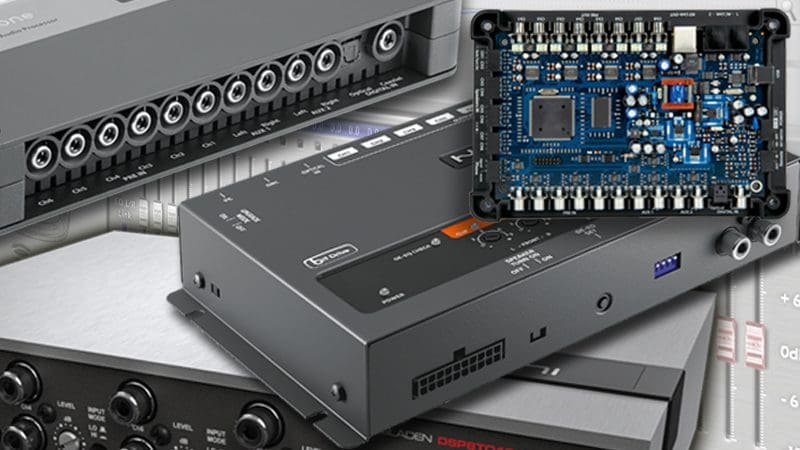 Adjusting or modifying audio signals is nothing new. Analog signal processors have been around recording studios and live performances for decades. Everything from equalizers to crossovers and compressors were conceived back when vacuum tubes were popular. As technology advanced, the size, cost and complexity of signal processors decreased. Now, many car audio source units contain more processing power than early recording studios. This article looks at digital signal processors (DSPs), what they do and why you need them.
Adjusting or modifying audio signals is nothing new. Analog signal processors have been around recording studios and live performances for decades. Everything from equalizers to crossovers and compressors were conceived back when vacuum tubes were popular. As technology advanced, the size, cost and complexity of signal processors decreased. Now, many car audio source units contain more processing power than early recording studios. This article looks at digital signal processors (DSPs), what they do and why you need them.
A Hostile Environment
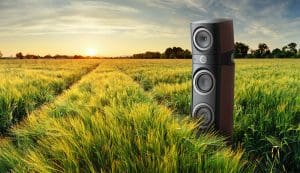 If we were to take a full-range home speaker into an open field and measure the frequency response, we’d see a fairly flat and smooth response curve. If you take that same speaker into a small room and measure the response again, you will see peaks and dips at various frequencies. This change in frequency response is not caused by the speaker, but by the room itself. Reflections cause nodes and anti-nodes (peaks and valleys) that dramatically affect the perceived frequency response of the speaker system. To maximize our enjoyment of that speaker, we need to apply signal correction to the speaker so what we hear is similar to what we would have experienced in that field.
If we were to take a full-range home speaker into an open field and measure the frequency response, we’d see a fairly flat and smooth response curve. If you take that same speaker into a small room and measure the response again, you will see peaks and dips at various frequencies. This change in frequency response is not caused by the speaker, but by the room itself. Reflections cause nodes and anti-nodes (peaks and valleys) that dramatically affect the perceived frequency response of the speaker system. To maximize our enjoyment of that speaker, we need to apply signal correction to the speaker so what we hear is similar to what we would have experienced in that field.
In a car, we are very rarely able to sit directly in the middle of the left and right speakers. The driver is usually twice as far from the right speaker as from the left. We hear the output of the left speaker first and it seems as if that speaker appears to be playing louder – because it is closer. Keep this in mind as we discuss digital signal processors (DSPs).
Speaker Limitations
No single speaker can reproduce the entire audio spectrum from 20 Hz to 20 kHz with accuracy, detail and even dispersion of sound. Even if there were one that could do this, the distortion levels in the midrange and high-frequency sounds would still be high because of the excursion requirements of the speaker at low frequencies. Because of this, we make use of several different speakers to cover the audio band. Woofers or subwoofers cover the bass, and typically play up to 80 or 100 hertz. Midrange drivers cover the range from 100 Hz to around 4,000 Hz. Finally, we use tweeters to cover the remainder of the frequencies above 4,000 Hz. While these are approximations, they are common crossover points for these speakers.
A crossover is a device that limits the passing of audio signals. There are two common types used in car audio: high-pass and low-pass. Their name describes their function. A high-pass crossover allows frequencies higher than the crossover point to pass through, and a low-pass allows frequencies below the crossover point to pass. A high-pass crossover would be used to keep the deep bass out of a small door or dash speaker, while a low-pass crossover is used to keep midrange and high-frequency information out of a subwoofer. We can combine both kinds of crossovers to produce what is known as a bandpass crossover – we limited the low- and high-frequency information. We would use this on a midrange speaker when combining it with a woofer and a tweeter. (We will discuss crossovers in detail in another article.)
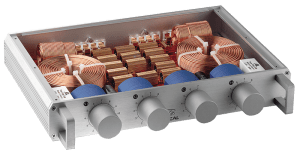 In car audio, we use both active and passive crossovers. Passive crossovers are a combination of capacitors, resistors and inductors that we connect to the speaker wires between the amp and the speaker. The behavior of the components, and how they are configured, limits what frequencies are allowed to pass through to the speaker.
In car audio, we use both active and passive crossovers. Passive crossovers are a combination of capacitors, resistors and inductors that we connect to the speaker wires between the amp and the speaker. The behavior of the components, and how they are configured, limits what frequencies are allowed to pass through to the speaker.
An active crossover is an electronic device that affects the frequency response of the signal before the amplifier. The benefit of active crossovers is that it is easy to adjust them to different frequencies. Most, if not all, crossover components have to be replaced to adjust the crossover frequency of a passive network.
This information gives us a basic understanding of why we need signal processing. For decades, the mobile electronics industry survived and thrived using analog processing. Companies like AudioControl, Phoenix Gold, Rockford Fosgate and Zapco made equalizers and crossovers, and enthusiasts flocked to them like moths to a flame.
As computing power advanced, we saw products like the Rockford Symmetry appear. The Symmetry was an electronically controlled analog processor – a fantastic creation that allowed users to make many adjustments from a single computerized control panel.
The next evolution in signal processing was to do everything in the digital domain, instead of analog. How does that work?
Building Blocks
A DSP is a powerful audio signal processor with hardware and software that is optimized to perform high-speed processing in real time. Some of the less-expensive processors include the analog-to-digital and digital-to-analog converters within the chip itself. On the higher-end units, the analog converters are external components. Better D/A converters offer increased resolution and improved signal-to-noise ratio performance. Once the audio signal is in the digital domain, one DSP doesn’t vary much from another. Algorithms are written in a similar fashion for filtering, equalization and time alignment.
Why would we want a DSP and not an analog processor? In a DSP, there are no associated concerns about component tolerances or temperature variations that will affect the response of the processing. With the right interface, users can access different system presets quickly and store an unlimited number of configurations on their computers. Most DSP units don’t include any analog adjustments, like potentiometers or switches, which can get dirty or wear out over time. Vibrations that could lead to component failure in an analog system rarely affect DSPs.
Features of Digital Signal Processors
Once an analog signal is converted to digital, the available signal processing is limited only by the software that is written for the chosen unit. The limit on the features of the software is typically determined by the available memory of the processor itself. It takes space to store the program, and additional space to store the converted analog information as the processor works with the information. When you see one processor with more features than another, the difference is usually a memory limitation.
Inputs And Signal Summing
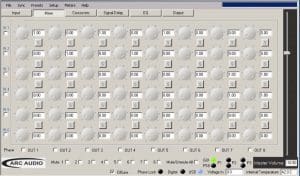 Most DSP units on the market can combine and adjust the level of audio signals on the input to the DSP. If you have a radio with front, rear and subwoofer outputs, you may want to maintain all of these channels discretely as you process the audio signal.
Most DSP units on the market can combine and adjust the level of audio signals on the input to the DSP. If you have a radio with front, rear and subwoofer outputs, you may want to maintain all of these channels discretely as you process the audio signal.
What about when you are trying to integrate with a factory amplifier? Perhaps you have a front door midrange and tweeter output from an amplifier that you need to use for your new front speakers. Most digital signal processors will allow you to combine signals from multiple inputs to facilitate applications like this.
Since different sources have different peak voltage levels, the inputs to your DSP have adjustable sensitivities. Just like the gain control on an amplifier, we want to set the input gains on our DSP to maximize the signal-to-noise ratio of the processor.
Crossovers And Filtering
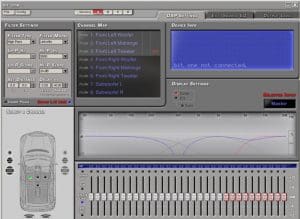 As we mentioned, different size speakers are designed to focus their performance within different audio ranges. A 3-inch midrange will not play the same frequency range as a 1-inch tweeter or a 6.5-inch woofer. We use the crossovers in the DSP to divide up the frequencies sent to each output and speaker.
As we mentioned, different size speakers are designed to focus their performance within different audio ranges. A 3-inch midrange will not play the same frequency range as a 1-inch tweeter or a 6.5-inch woofer. We use the crossovers in the DSP to divide up the frequencies sent to each output and speaker.
A benefit of doing all the crossover processing in the digital domain is that many digital signal processors offer different crossover filter alignments and roll-off slopes. The alignment describes the shape of the roll-off around the -3 dB point. This shape also affects how signals sum back together acoustically. Options are Butterworth, Linkwitz-Riley, Chebychev, Bessel and more. It’s not that one is better than another, but that each is distinct and different. We could write an entire article about crossover alignments.
The crossover slope describes how fast the audio stops playing as a signal moves away from the crossover point. Because it’s all digital, most digital signal processors offer slopes from -6 dB to -48 dB per octave, in steps of 6 dB or 12 dB, depending on the chosen alignment. In most cases with DSPs, 24 dB/Octave Linkwitz-Riley filtering works quite well, but there are dozens of different tuning approaches, so use what works well for you.
Time Alignment And Signal Delay
One of the coolest features of a digital signal processor is its ability to store the audio signal for a variable amount of time before sending it to the speaker. This storage ability allows a properly trained installer to delay the signal going to the speakers closest to the listener so the sound from created by them arrives at the listening position at the same time as the rest of the speakers. For four-way systems (subwoofer, midbass, midrange and tweeter), this setup and fine-tuning can take a little time.
Equalization
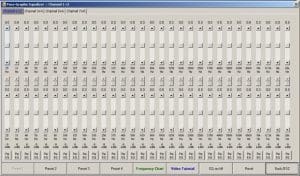 The ability to fine-tune the frequency response of each speaker in an audio system is a huge key to making that system sound amazing. We have to measure the response of each speaker at the listening position, then adjust the equalizer so each speaker produces a smooth response. There are many ways to achieve this.
The ability to fine-tune the frequency response of each speaker in an audio system is a huge key to making that system sound amazing. We have to measure the response of each speaker at the listening position, then adjust the equalizer so each speaker produces a smooth response. There are many ways to achieve this.
Graphic equalizers typically offer 31 bands of equalization per channel and are spaced 1/3 of an octave apart. This spacing usually provides enough frequency resolution to resolve response issues. Graphic equalizers are easy to understand: You pick the desired frequency band, then boost or cut the signal by the amount of your choice.
Parametric equalizers are much more powerful, but can be a little more difficult to configure. In a parametric equalizer, the user can choose the frequency, bandwidth and amount of signal boost or reduction. Understanding the selection of frequency is simple, but understanding filter Q factor is more difficult. When it comes to Q, the basic concept is that a higher number means that the band adjustment affects a narrower range of frequencies. A low number, like 0.7 or 1, covers a wider range of frequencies. Setting up a parametric equalizer accurately takes some practice. That said, some software applications will provide setting information automatically after you measure the frequency response of the speaker or system.
Output Level And Remote Controls
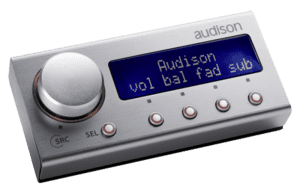 Having the ability to tune the output level of each speaker finely is critical to the performance of an audio system. To achieve an accurate and balanced soundstage, the amplitude (level) of each speaker in the system must be adjusted very accurately. Output level control is also quite important to matching the efficiency of the different speakers.
Having the ability to tune the output level of each speaker finely is critical to the performance of an audio system. To achieve an accurate and balanced soundstage, the amplitude (level) of each speaker in the system must be adjusted very accurately. Output level control is also quite important to matching the efficiency of the different speakers.
Many DSP units have the option of a remote control. These controls can be used to adjust the overall system volume and adjust the subwoofer output level, and can typically load presets for the processor. More advanced controllers give you access to some of the system tuning features, allowing you to make adjustments without the need for a laptop computer. Displays on these remote controls vary from simple single-color dot-matrix LCD panels to full-color OEL displays that are easy to see in bright sunlight.
Digital Signal Processor Tuning – Art Or A Process?
There are many schools of thought about how to configure a DSP. Whether you do it using instrumented measurements or different acoustic techniques, we want to achieve proper protection for the speakers, smooth frequency response from both channels of the audio system and aligned arrival times from each speaker.
Many car audio manufacturers train their dealers in different methods of achieving a great “tune” on their customer vehicles. If you are looking to improve the sound of your mobile entertainment system and already have great speakers and amplifiers, visit your local car audio professional. They would be happy to demonstrate the benefits of DSPs, and provide you with the information you need to make an educated decision about buying one.
This article is written and produced by the team at www.BestCarAudio.com. Reproduction or use of any kind is prohibited without the express written permission of 1sixty8 media.